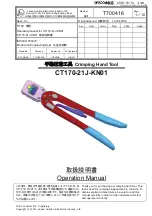
G1 Versi-Tugger™
Greenlee Tools, Inc.
4455 Boeing Dr. • Rockford, IL 61109-2988 USA • 815-397-7070
8
CABLE PULLING OVERVIEW
Cable Pulling Glossary
Anchoring system
any item or group of items that keeps a cable pulling
component in place during the cable pull
Capstan
the tapered cylinder of the cable puller that acts on the
pulling rope to generate pulling force
Connector
any item, such as a wire grip, clevis, swivel, or pulling
grip, that connects the rope to the cable
Direct line of pull
the areas next to the pulling rope and along its path;
this includes the areas in front of, in back of, and
underneath the rope
Maximum rated capacity
the amount of pulling tension that any component
can safely withstand, rated in kilonewtons (metric)
or pounds; the maximum rated capacity of every
component must meet or exceed the maximum pulling
force of the cable puller
Pulling grip
connects the rope to the cable; consists of a wire mesh
basket that slides over the cable and grips the insulation
Pulling force
the amount of pulling tension developed by the cable
puller, rated in newtons (metric) or pounds; a cable
puller is usually described by the maximum pulling force
that it can develop
Sheave
a pulley that changes the direction of the rope and cable
Support structure
any stationary object that a cable pulling system
component is anchored to, such as a concrete floor
(for the floor mount) or an I-beam (for a sheave)
Tail
the portion of the rope that the operator applies force
to; this is the rope coming off of the capstan, and is not
under the tension of the pull
Tailing the rope
the operator’s main function; this is the process of
applying force to the tail of the pulling rope—refer to the
complete explanation under “Cable Pulling Principles”
Wire grip
connects the rope to the cable; some use a set screw to
clamp onto the conductors of the cable
Planning the Pull
• Pull in a direction that will require the lowest amount
of pulling force.
• Plan several shorter pulls rather than fewer longer
pulls.
• Locate the puller as close to the end of the conduit
as possible to minimize the amount of exposed rope
under tension.
• Place each component so that the pulling forces are
used effectively.
• Verify that each component has the proper
load rating.
• Inspect the structural supports. Verify that they have
enough strength to withstand the maximum forces
that may be generated.









































